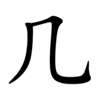几
| ||||||||
Translingual
| Stroke order | |||
|---|---|---|---|
| Stroke order | |||
|---|---|---|---|
 | |||
Han character
几 (radical 16, 几+0, 2 strokes, cangjie input 竹弓 (HN), four-corner 77210, composition ⿰丿㇈)
- Kangxi radical #16, ⼏.
- Shuōwén Jiězì radical №493
Usage notes
This character is not to be confused with 𠘧 (U+20627) which is another radical in Shuōwén.
Derived characters
Related characters
- 幾 (Traditional form of 几)
References
- KangXi: page 133, character 57
- Dai Kanwa Jiten: character 1737
- Dae Jaweon: page 299, character 8
- Hanyu Da Zidian: volume 1, page 275, character 19
- Unihan data for U+51E0
Chinese
Glyph origin
| Historical forms of the character 几 | ||
|---|---|---|
| Warring States | Shuowen Jiezi (compiled in Han) | Liushutong (compiled in Ming) |
| Chu Slip and silk script | Small seal script | Transcribed ancient scripts |
 |
 |
 |
| Characters in the same phonetic series (几) (Zhengzhang, 2003) | |
|---|---|
| Old Chinese | |
| 肌 | *kril |
| 飢 | *kril |
| 机 | *kril, *krilʔ |
| 虮 | *kril |
| 几 | *krilʔ |
| 麂 | *krilʔ |
Etymology 1
| simp. and trad. |
几 | |
|---|---|---|
| variant forms | 𠀃 | |
From Proto-Sino-Tibetan *krəj (“foot, leg; stool”). Compare Tibetan ཁྲི (khri) and Burmese ခြေ (hkre).
Pronunciation
Compounds
|
|
|
Etymology 2
| For pronunciation and definitions of 几 – see 幾 (“how much; how many; what; which; etc.”). (This character, 几, is the simplified form of 幾.) |
Notes:
|
Etymology 3
| For pronunciation and definitions of 几 – see 人 (“man; person; people; human being; etc.”). (This character, 几, is a variant form of 人.) |
Japanese
Korean
Hanja
几 • (gwe) (hangeul 궤, revised gwe, McCune–Reischauer kwe)
- This term needs a translation to English. Please help out and add a translation, then remove the text
{{rfdef}}.
Vietnamese
Han character
几 (kỉ)
- This term needs a translation to English. Please help out and add a translation, then remove the text
{{rfdef}}.
This article is issued from
Wiktionary.
The text is licensed under Creative
Commons - Attribution - Sharealike.
Additional terms may apply for the media files.